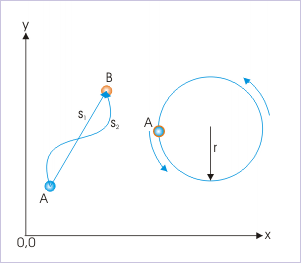| << Chapter < Page | Chapter >> Page > |
Distance represents the magnitude of motion in terms of the "length" of the path, covered by an object during its motion. The terms "distance" and "distance covered" are interchangeably used to represent the same length along the path of motion and are considered equivalent terms. Initial and final positions of the object are mere start and end points of measurement and are not sufficient to determine distance. It must be understood that the distance is measured by the length covered, which may not necessarily be along the straight line joining initial and final positions. The path of the motion between two positions is an important consideration for determining distance. One of the paths between two points is the shortest path, which may or may not be followed during the motion.
Distance

In the diagram shown above, , represents the shortest distance between points A and B. Evidently,
The concept of distance is associated with the magnitude of movement of an object during the motion. It does not matter if the object goes further away or suddenly moves in a different direction or reverses its path. The magnitude of movement keeps adding up so long the object moves. This notion of distance implies that distance is not linked with any directional attribute. The distance is, thus, a scalar quantity of motion, which is cumulative in nature.
An object may even return to its original position over a period of time without any “net” change in position; the distance, however, will not be zero. To understand this aspect of distance, let us consider a point object that follows a circular path starting from point A and returns to the initial position as shown in the figure above. Though, there is no change in the position over the period of motion; but the object, in the meantime, covers a circular path, whose length is equal to its perimeter i.e. 2πr.
Generally, we choose the symbol 's' to denote distance. A distance is also represented in the form of “∆s” as the distance covered in a given time interval ∆t. The symbol “∆” pronounced as “del” signifies the change in the quantity before which it appears.
Distance is a scalar quantity but with a special feature. It does not take negative value unlike some other scalar quantities like “charge”, which can assume both positive and negative values. The very fact that the distance keeps increasing regardless of the direction, implies that distance for a body in motion is always positive. Mathematically :
Since distance is the measurement of length, its dimensional formula is [L] and its SI measurement unit is “meter”.
Distance – time plot is a simple plot of two scalar quantities along two axes. However, the nature of distance imposes certain restrictions, which characterize "distance - time" plot.

Notification Switch
Would you like to follow the 'Physics for k-12' conversation and receive update notifications?